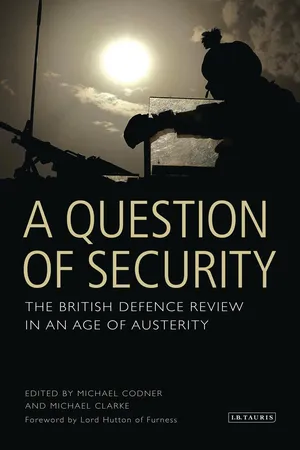
A Question of Security
The British Defence Review in an Age of Austerity
- 368 pages
- English
- ePUB (mobile friendly)
- Available on iOS & Android
A Question of Security
The British Defence Review in an Age of Austerity
About This Book
Britain now faces fundamental choices in organising its armed forces and military strategy - more so than at any time since the 1930s. This vital new book prepares the ground for a major government review of UK defence and security policy, analysing every important facet the review will face: from the spending constraints created by the financial crisis, to the decisions the country has to take on matters of war, peace and terrorism. The analysis covers the military equipment Britain should procure; the industrial implications of defence procurement decisions; the relationship with allies and partners; the intelligence sources; and, not least, the moral and ethical dimensions of modern security policy in a globalised but disordered world. Written by the foremost independent security and defence experts in the field, this book is the result of RUSI's Future Defence Review research initiative. 'A Question of Security' sets the core agenda for all wishing to understand the defence and security problems Britain now faces, and also for those in government and parliament who have to answer these difficult questions at a generational moment for UK defence policy.
Frequently asked questions
Information
Table of contents
- Cover
- Author biography
- Title page
- Copyright page
- Contents
- List of Tables and Figures
- Acronyms and Abbreviations
- Foreword
- Introduction
- Grand Strategy
- The United Kingdom’s Strategic Moment
- Multilateral Approaches to British Security
- The Lean Years: Defence Consequences of the Fiscal Crisis
- Partners and Problems
- Strategic Considerations for the Anglo-American Alliance
- Entente or Oblivion: Franco-British Defence Co-operation
- The SDSR and China
- Ways and Means
- British Strategy after Afghanistan
- A Force for Honour? UK Military Strategic Options
- Jointery and the Defence Review
- The Special Relationship and the British Army
- Redefining the Military’s Role in Domestic Security
- Delivery
- The Case for the RAF
- Armed Inducement in Conflict Prevention
- Defence Information Superiority: Still Underplayed
- Failing Intelligence: Reform of the Machinery
- The Armed Forces and the British People
- Procurement Reform
- Defence Industrial Strategy under the Coalition
- Conclusion
- References
- About the Authors